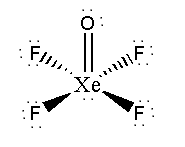
What is the structure of $$XeO{F_4}$$ ?
(A) Square pyramidal
(B) Trigonal bipyramidal
(C) Pyramidal
(D) Square bipyramidal
Answer
143.4k+ views
Hint: With the help of lewis structure, we can know the bonding in the compound and predict the shape. Xenon is the central atom in this structure. Hybridization in this molecule is $$s{p^3}{d^2}$$.
Complete Step-by-Step Answer:
We can draw the lewis structure of the compound, so that we will get the idea about the shape of the molecule.
We know that Fluorine generally binds with one atom and oxygen generally binds with two atoms. This structure involves six atoms. So, Xenon must be the central atom.
In the lewis structure, Xenon has 8 valence electrons as it is a noble gas, oxygen has 6 electrons and fluorine has 7 valence electrons. Let’s make bonds between them and see the structure.

We can see that xenon uses 4 of its electrons to make bonds with 4 fluorine atoms. 2 of the valence electrons of xenon make double bonds with oxygen and the remaining two are as a lone pair.
As lone pairs have strong repulsive effects on bonds, Xe-F bonds have a tendency to be as far as possible from the lone pair.
Xenon-Oxygen double bonds also have a repulsive effect as oxygen and fluorine atoms have 2 and 3 lone pairs respectively.
So, Xe-F bonds lie in a plane to make repulsive forces least as possible and on two sides of the plane, oxygen atoms and lone pairs reside.
So, the correct answer is (A) Square pyramidal.
Additional Information:
VSEPR theory is also helpful in order to determine the geometry of the molecule. VSEPR stands for Valence shell electron pair repulsion theory. It involves consideration of various electron pairs present in the molecule and considering those repulsive forces, structure is assigned.
Note: As $$XeO{F_4}$$ has 5 other atoms than the central atom xenon, it simply doesn’t mean that it has trigonal bipyramidal structure. Do not forget to consider the lone pair in the central atom as well because it has the highest repulsive forces on the atoms which are bonded with the central atom.
Complete Step-by-Step Answer:
We can draw the lewis structure of the compound, so that we will get the idea about the shape of the molecule.
We know that Fluorine generally binds with one atom and oxygen generally binds with two atoms. This structure involves six atoms. So, Xenon must be the central atom.
In the lewis structure, Xenon has 8 valence electrons as it is a noble gas, oxygen has 6 electrons and fluorine has 7 valence electrons. Let’s make bonds between them and see the structure.

We can see that xenon uses 4 of its electrons to make bonds with 4 fluorine atoms. 2 of the valence electrons of xenon make double bonds with oxygen and the remaining two are as a lone pair.
As lone pairs have strong repulsive effects on bonds, Xe-F bonds have a tendency to be as far as possible from the lone pair.
Xenon-Oxygen double bonds also have a repulsive effect as oxygen and fluorine atoms have 2 and 3 lone pairs respectively.
So, Xe-F bonds lie in a plane to make repulsive forces least as possible and on two sides of the plane, oxygen atoms and lone pairs reside.
So, the correct answer is (A) Square pyramidal.
Additional Information:
VSEPR theory is also helpful in order to determine the geometry of the molecule. VSEPR stands for Valence shell electron pair repulsion theory. It involves consideration of various electron pairs present in the molecule and considering those repulsive forces, structure is assigned.
Note: As $$XeO{F_4}$$ has 5 other atoms than the central atom xenon, it simply doesn’t mean that it has trigonal bipyramidal structure. Do not forget to consider the lone pair in the central atom as well because it has the highest repulsive forces on the atoms which are bonded with the central atom.
Recently Updated Pages
How to find Oxidation Number - Important Concepts for JEE

How Electromagnetic Waves are Formed - Important Concepts for JEE

Electrical Resistance - Important Concepts and Tips for JEE

Average Atomic Mass - Important Concepts and Tips for JEE

Chemical Equation - Important Concepts and Tips for JEE

Concept of CP and CV of Gas - Important Concepts and Tips for JEE

Trending doubts
JEE Main 2025 Session 2: Application Form (Out), Exam Dates (Released), Eligibility, & More

JEE Main Exam Marking Scheme: Detailed Breakdown of Marks and Negative Marking

JEE Main 2025: Derivation of Equation of Trajectory in Physics

Electric Field Due to Uniformly Charged Ring for JEE Main 2025 - Formula and Derivation

Types of Solutions

Degree of Dissociation and Its Formula With Solved Example for JEE

Other Pages
JEE Advanced Marks vs Ranks 2025: Understanding Category-wise Qualifying Marks and Previous Year Cut-offs

JEE Advanced 2025: Dates, Registration, Syllabus, Eligibility Criteria and More

NCERT Solutions for Class 11 Chemistry Chapter 5 Thermodynamics

JEE Advanced Weightage 2025 Chapter-Wise for Physics, Maths and Chemistry

Hydrocarbons Class 11 Notes: CBSE Chemistry Chapter 9

NCERT Solutions for Class 11 Chemistry In Hindi Chapter 1 Some Basic Concepts of Chemistry




